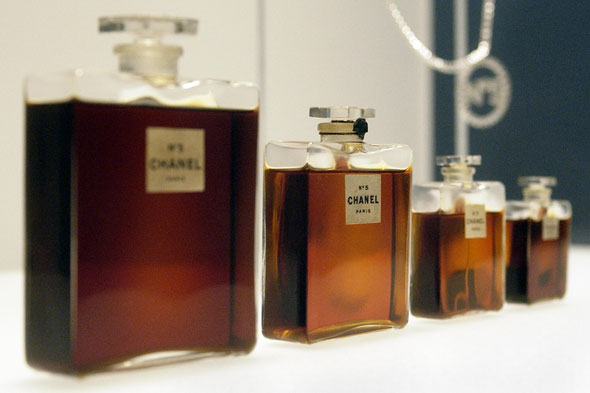Design
Chanel envisioned a design that would be an antidote for the over-elaborate, precious fussiness of the crystal fragrance bottles then in fashion popularized by Lalique and Baccarat. Her bottle would be “pure transparency ...an invisible bottle.” It is generally considered that the bottle design was inspired by the rectangular beveled lines of the Charvet toiletry bottles, which, outfitted in a leather traveling case, were favored by her lover, Arthur “Boy” Capel.[6] Some say it was the whiskey decanter he used that she admired and wished to reproduce in “exquisite, expensive, delicate glass.”
The first bottle produced in 1919, differed from the Chanel No. 5 bottle known today. The original container had small, delicate, rounded shoulders and was sold only in Chanel boutiques to select clients. In 1924, when “Parfums Chanel” incorporated, the glass proved too thin to sustain shipping and distribution. This is the point in time when the only significant design change took place. The bottle was modified with square, faceted corners.
In a marketing brochure issued in 1924, “Parfums Chanel” described the vessel, which contained the fragrance: “the perfection of the product forbids dressing it in the customary artifices. Why rely on the art of the glassmaker ...Mademoiselle is proud to present simple bottles adorned only by ...precious teardrops of perfume of incomparable quality, unique in composition, revealing the artistic personality of their creator.”
Unlike the bottle, which has remained the same since the 1924 redesign, the stopper has gone through numerous modifications. The original stopper was a small glass plug. The octagonal stopper, which became a brand signature, was instituted in 1924, when the bottle shape was changed. The 1950s gave the stopper a bevel cut and a larger, thicker silhouette. In the 1970s the stopper became even more prominent but, in 1986, it was re-proportioned so its size was more harmonious with the scale of the bottle.
The “pocket flacon” devised to be carried in the purse was introduced in 1934. The price point and container size were developed to appeal to a broader customer base. It represented an aspirational purchase, to appease the desire for a taste of exclusivity in those who found the cost of the larger bottle prohibitive.

